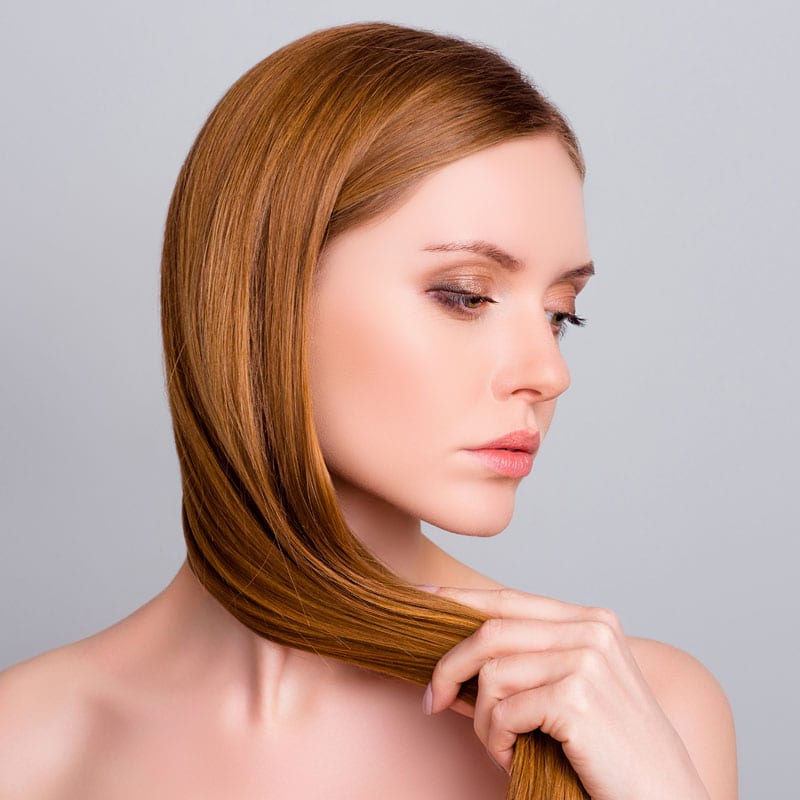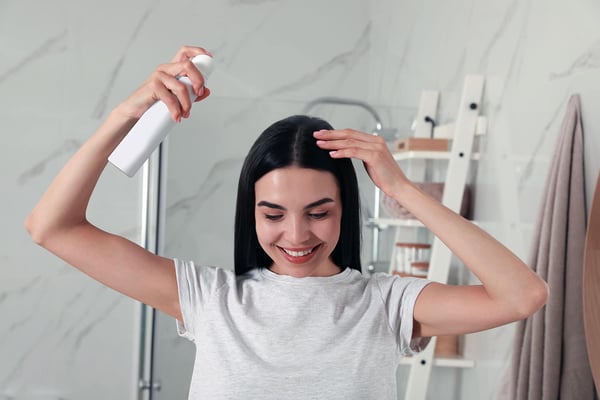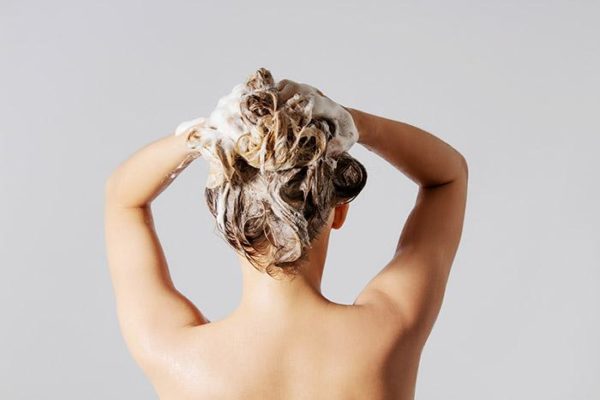How To Care for Oily Hair: Product and Lifestyle Guide
Oily hair tends to be caught in a cycle of sebum overproduction. If your hair is so greasy that you wash it more often than once a day, your routine actually contributes toward oiliness. Cleansing hair too frequently with harsh sulfates instead of a good shampoo for oily hair can cause sebaceous glands to overproduce oil.
Excessive oil can diminish the appearance of healthy hair and eventually lead to hair loss if follicles become inflamed. Find out more about the causes of oily hair and the most effective solutions for this hair condition as well as products you might prefer to eliminate from your routine to balance oil levels.

While oil accumulates in all hair between washes, oily hair can get weighed down with sebum almost immediately. Combination hair is even more challenging to care for and calls for a focus on balance.
The oil in hair is the same as the oil in skin. Sebum is an oily, waxy substance produced by the sebaceous glands. This natural oil coats the skin, scalp and hair to preserve moisture and protect against damage. Sebum consists of a combination of fatty acids, sugars, waxes and natural chemicals.

Finding the effective ways to make hair less oily involves identifying any internal and external factors contributing to oil overproduction. Many people are genetically predisposed to have oily hair or suffer from scalp issues but can still manage oil levels. Other internal factors include hormone imbalances and certain medications.
Sebum production is closely related to the endocrine system and adrenal and pituitary glands. Medications that affect levels of testosterone, estrogen or progesterone in the body may increase or decrease the oiliness of skin and hair.
Using the wrong hair care and styling products is the primary external cause of oiliness. From harsh cleansers to moisturizing or smoothing conditioners, products that strip away every trace of natural oil or coat strands and leave behind buildup make oiliness worse.
Oily buildup in hair does not consist entirely of sebum. This substance mixes with dead skin cells, dirt and sweat on the scalp and strands. As a result, hair may feel heavy and thick and look dull and lifeless. Focusing on quick fixes will not reduce the oiliness of hair. You will need to switch to a good shampoo for oily hair and make other fundamental changes to the way you care for and style your hair.

Although this advice may seem likely to lead to oily strands, this problem should only persist for several weeks. After a period of readjustment, hair should become less oily overall. One reason oily hair has a reputation for being difficult to deal with is that the same techniques that balance oil levels can also cause imbalances based on your hair type and the frequency of treatment.
Washing hair reduces the amount of oil present, but overwashing can stimulate oil production to replenish lost moisture. It is possible to overwash your hair in one or more ways. Washing strands every day or more than twice a week may stimulate oil production.
Any time you use a shampoo formulated with harsh sulfate-based cleansing agents you will also strip away natural oils and may shock sebaceous glands. While a gentle clarifying shampoo is helpful to use once a week or twice a month, the same product can make hair more oily if you use it every day.
Brushing hair with a boar bristle or faux boar bristle brush redistributes oil between scalp and strands. This hair care procedure is helpful prior to using dry shampoo or blotting papers for a temporary fix for greasy locks. When oil shifts down the hair shaft, sebaceous glands can take this as a signal to make more oil to compensate for the loss.
Oil travels down straight strands faster than on hair with curly or wavy textures. You may want to consider curling hair with a curling iron or doing a process to alter the texture to slow the progress of oil down strands. The way you style hair can cause it to appear more or less oily.
Putting your hair up in a ponytail is a quick fix for oily hair, but pulling hair back repeatedly and keeping strands close to the scalp causes oils to spread faster and make full length of hair look greasy. Try wearing hair in a looser style such as a half-up bun or out to get more wear between washes.

Whether you use shampoo for oily strands or a balancing or clarifying cleanser, your shampoo should not contain harsh cleansers such as sodium lauryl sulfate. If you suffer from dandruff, consider using an anti-dandruff shampoo formulated with ketoconazole, selenium sulfide or salicylic acid to balance oil levels and eliminate flaking.
Oily hair may seem moisturized, but you should still apply a lightweight conditioner after cleansing. You may find it helpful to only apply conditioner to ends to keep the scalp and strands from looking flat or greasy. You can also try pre-conditioning hair, or applying conditioner prior to shampooing. Another option is to use shampoo and apply leave in conditioner to the lower portion of strands.
Once hair is brought into balance, applying conditioner to the full length of hair may help to reduce overall oiliness by immediately restoring moisture levels after a clarifying treatment. Using a shampoo to remove buildup is particularly important if you rely on dry shampoo or texturizing products to prolong styles between washes.

Changing how you handle hair can also be helpful for keeping oil levels low. Touch your hair as little as possible to avoid transferring oils from your fingers or face to your scalp and strands. You should also avoid brushing hair more than twice a day, as friction distributes oil down strands. Sebaceous glands may produce more oil to compensate, which leads to greasy roots and lengths.
Another beneficial change involves avoiding heat exposure. Rinsing hair with hot water eliminates natural oils and encourages glands to compensate by overproducing sebum. Heat styling tools also have a drying effect and stimulate oil production, particularly flat irons and blow dryers.
The way you style hair also determines how oily it looks and feels. When hair has been straightened with a flat iron, the strands and scalp are exposed to intense heat. Stick-straight strands also lay closer to the scalp between the roots and ears and will become oily faster as a result.
Curling oily hair or using volumizing or texturizing products can give roots lift. When the upper portion of strands makes less contact with the surface of the scalp, it may take longer for hair to become noticeably oily. It also takes longer for oils to travel down textured strands than straight hair.
The same principle of creating distance between the scalp and strands applies to how you wear your hair while sleeping. If you want to wash your hair less frequently to balance oil levels, consider going to bed with hair up in a loose knot. This style reduces oil transference to help you avoid waking up with oily tresses if you wash your hair in the evening or are planning to wear a style for a second day. Skincare experts also recommend changing your pillowcase at least once a week.

Always apply conditioner after washing hair. You may prefer to only apply this product to ends and avoid the scalp and root area. Style hair with volumizing or texturizing formulas to create lift. Distancing roots from the scalp may make it possible to keep hair from becoming oily as quickly.
If oily hair is prone to dandruff, try gently exfoliating your scalp with a product safe for your hair condition. Try using a shampoo that contains salicylic acid, selenium sulfide or ketoconazole. You may want to look for dandruff products formulated for use on an oily scalp. Depending on the severity of symptoms, you may prefer to use homemade, consumer grade or prescription treatments.
People with oily hair benefit most from using dry shampoo to soak up natural oil. A spray or powder formula can instantly bring oil levels into balance. Apply dry shampoo spray to the root area in short bursts. Shake on powdered dry shampoo or use an applicator. Leave dry shampoo in hair about two minutes before tousling or brushing strands to remove excess product. You may prefer to use a formula made for your hair color, particularly if your hair is dark.
Dry shampoo is helpful for oily hair in two ways. This product may make it possible to maintain a style for at least two days, which reduces the frequency of washing. This may also make it easier to transition from more to less frequent washes, which can bring oil levels into balance and make hair less oily.

Silicone is an effective smoothing ingredient, but the use of non-water-soluble forms of silicone can leave behind buildup. Even silicone-based products formulated to rinse out of hair may not be the best options for oily hair.
In general, greasy and sticky styling products have no place in a regimen focused on how to get rid of oily hair. Coating hair in heavy products can cause strands to appear more dull and limp, which may already be problems with hair that tends to be oily. A good shampoo for oily hair will be balancing or clarifying and you should use a lightweight or volumizing conditioner.
Adjusting your hair care routine can break the cycle that makes hair excessively oily. Some level of oil is necessary to seal in moisture and protect strands from damage. It may take time, but it is possible to discourage sebaceous glands from overproducing oil and manage the appearance of oily hair as it adjusts to a balancing routine.
The Best Treatment for Oily Hair That’s Searching for Some Balance
To wash or not to wash? That is the struggle that people [Read More...]
Get the Best Dry Shampoo for Oily Hair from these 8 Standouts in 2022
By Laura Bissessar Some people naturally have oily hair, and some people [Read More...]
Our Favorite Dry Shampoo for Fresh-Looking Hair Fast
Dry shampoo is the best product to use when you need to [Read More...]
How To Get Rid of Greasy Hair
If you have fine hair, you’ve probably noticed its tendency to get [Read More...]
Best Shampoos to Get You to Stop Singing the Oily Hair Blues
There’s a thin line between well-moisturized hair and oily hair. Hair that [Read More...]
Choosing the Best Shampoo for Your Hair Type
The right shampoo can help make your hair beautiful and vibrant. When [Read More...]







